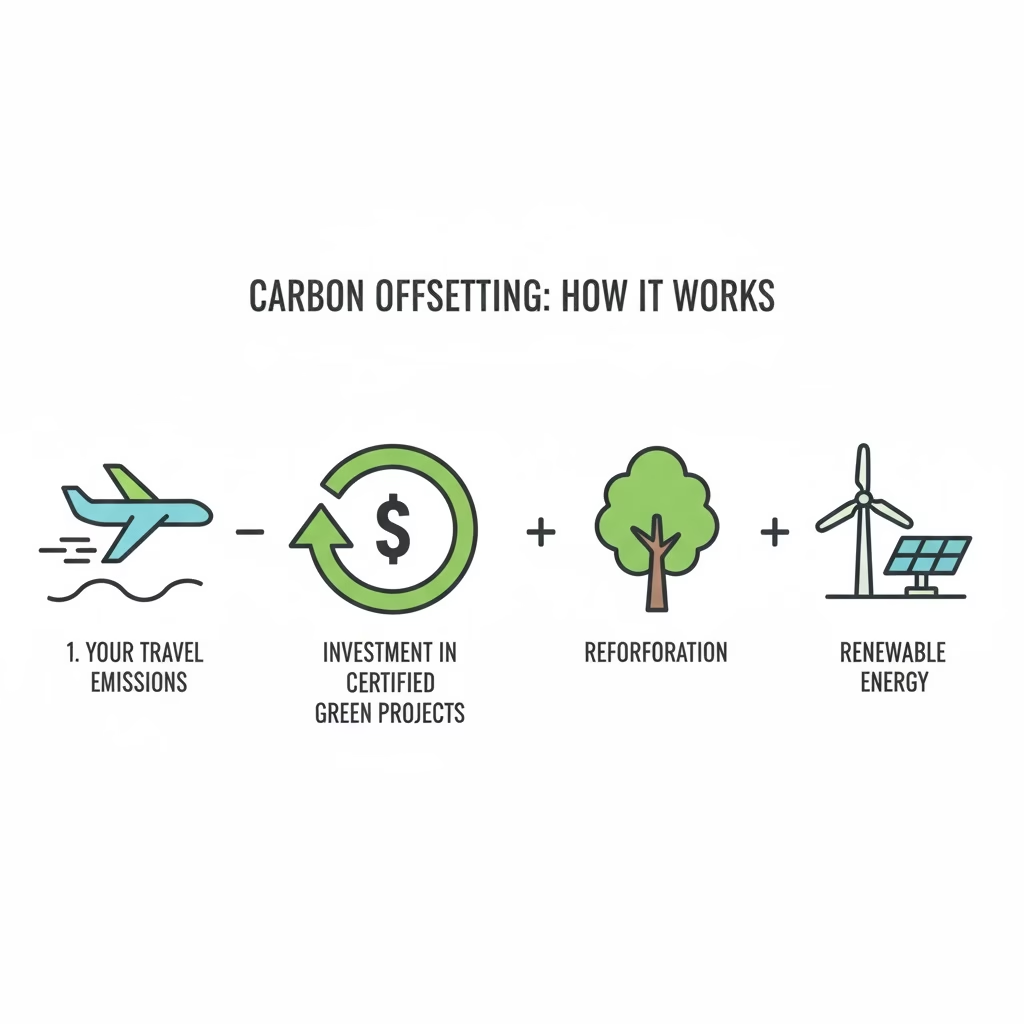
If you have always wanted to explore amazing places without causing harm. For years, I found it hard to tell the difference between real Eco-Friendly sustainable trips and just clever ads. This made choosing an Eco-Friendly vacation a guessing game. This guide comes from my own travel research and personal trips. It should help you travel with confidence and joy.
The Eco-Friendly Imperative: Why Your Next Trip Needs to Be Responsible
The urge to get away is powerful. We crave the promise of new sights, sounds, and experiences. However, we also know more now about the planet’s needs. This makes us want to travel in a better, more responsible way. Today, the phrase “eco-friendly vacation” is everywhere. You see it on every website and travel brochure.
But what does it really mean to travel sustainably? More important, how can you spot a true commitment from a simple marketing trick?
This complete guide will give you the knowledge you need. You’ll learn how to plan a trip that not only lifts your spirits but also respects the earth and its people. We’ll look at the core ideas of eco-friendly travel. We will give you easy “how-to” steps and clear examples. This will make sure your next trip leaves a positive mark.

The Four Main Parts of an Eco-Friendly Trip
To choose well, you must first know what makes a vacation truly eco-friendly. It is much more than just putting bottles in the recycling bin. It is a full approach that cuts down on bad effects and boosts good ones.
- Protecting Nature: This is the clearest goal. It means reducing your carbon footprint. And also saving resources like water and energy. It means guarding wildlife and keeping garbage to a minimum. You must choose companies that actively work to protect the local ecosystems.
- Helping Local People: Real eco-tourism must benefit the local people you visit. This includes paying fair wages and providing good jobs. It means supporting local shops and businesses. It also involves respecting their culture. Locals should be part of the travel decisions. Tourism should help the community, not exploit it.
- Saving Culture: Sustainable travel means you must respect local ways, traditions, and sacred places. It encourages real, positive connections. You should avoid any activities that treat local customs like products to be sold.
- Local Economy: For eco-tourism to last, it must also be good for local people’s wallets. This means creating jobs. It means the money you spend stays in the area. It gives locals a clear reason to protect their natural resources.

The Greenwashing Trap: How to Spot Fakes
Greenwashing is when companies pretend to be green. They trick people into thinking their services are good for the environment. This happens a lot in the travel business. A hotel might show a sign asking you to reuse towels. At the same time, it may use huge amounts of power with no plan to use clean energy.
How to Spot Greenwashing:
- Vague Statements: Be wary of simple claims like “eco-conscious.” They need to provide specific details or proof.
- Lack of Clear Facts: If a business won’t show clear facts about their green or social work, be suspicious.
- Focus on Only One Tiny Thing: A hotel may only talk about its recycling plan. But it may ignore its high water use or poor treatment of workers.
- No Official Proof: A trusted certificate or third-party check helps. Without one, the claims are hard to verify.
- Misleading Pictures: Photos of beautiful nature do not prove the business is sustainable.

Step-by-Step: How to Plan a Truly Eco-Friendly Vacation
We know the basics and the traps. Now, let’s go through the simple steps for planning your next responsible adventure.
Step 1: Research Where You Go Carefully
Your choice of destination is the most important step. Some places are more sensitive. Others have better systems for sustainable tourism.
- Try Off-Season Travel: Traveling when it’s less crowded is smarter. This takes the pressure off local services and wildlife. It often gives you a more real experience.
- Choose Places That Care: Look for countries or parks with clear sustainability plans. Choose places known for their conservation efforts. Costa Rica is a famous example.
- Skip Over-Crowded Spots: Too many tourists often damage nature and local culture. Look for places that are actively managing visitor numbers.

Step 2: Choose Greener Ways to Travel
The way you travel often creates the biggest part of your trip’s carbon footprint.
- Fly Less: If a long flight is a must, think about paying to offset your carbon. This isn’t a perfect fix, but it does help. Choose direct flights. Take-offs and landings use the most fuel.
- Use Better Alternatives: For shorter distances, trains, buses, bikes, and walking are far more eco-friendly.
- Pick Eco-Friendly Local Transport: Once you arrive, walk, bike, or use public transport. If you must rent a car, get an electric or hybrid vehicle.
- Example: Don’t fly from Seattle to Vancouver. Take the Amtrak train. It’s scenic and much better for the earth. In a city, use the metro instead of ride-shares.

Step 3: Pick Certified Sustainable Places to Stay
Trusted third-party proof is very helpful here. Look for this proof when booking.
- Look for Real Proof/Certificates: Search for hotels and guesthouses that have been checked by known organizations. Examples include:
- Green Globe: A worldwide standard for sustainable tourism.
- EarthCheck: A major science group that rates travel businesses.
- Travelife: This group focuses on accommodations and tour companies.
- Ask More Questions: Even without a certificate, you can ask about their habits:
- Do they use clean energy?
- How do they save water and handle trash?
- Do they get food from local farmers?
- Can they hire and train local people fairly?
- Do they give money to local conservation?
- Example: A hotel shows commitment by using solar power. It also uses recycled water for gardening. Plus, it only buys meat and produce from nearby farms, helping the local economy.

Step 4: Choose Responsible Tours and Activities
What you do on your trip has a direct effect.
- Find Companies with Clear Green Rules: Look for tour companies that state they protect nature and help the local community.
- Prefer Small Group Tours: Smaller groups are less likely to damage sensitive environments. They also give you better cultural contact.
- Say No to Animal Exploitation: Never pay for things like elephant rides or swimming with captive sea life. Always research animal encounters. Make sure it is ethical (e.g., watching wild animals from a respectful distance).
- Hire Local Guides: Local guides offer better insights. This also puts money directly into their hands.
- Example: Instead of a huge, loud jeep tour, pick a small, locally-led bike tour. Your guide can teach you about the area’s history and plants.

Step 5: Pack Smart and Light
What you take (or don’t take) matters to the environment.
- Bring Reusables: Always pack a reusable water bottle, coffee cup, and shopping bag. This cuts down on plastic trash.
- Use Eco-Friendly Toiletries: Use sunscreen that won’t harm coral reefs. Use soaps that break down easily to protect rivers and oceans.
- Pack Less: Lighter luggage means less fuel is burned during travel.
- Example: Use a portable water filter bottle. This means you don’t have to buy plastic bottles, which is vital in places with poor tap water.

Step 6: Be a Responsible Tourist While You’re There
Your actions on the ground are key to a successful eco-friendly trip.
- Respect Local Culture: Learn a few words in the local language. Dress respectfully. Always ask before taking pictures of people. Respect all local traditions.
- Save Resources: Turn off the lights and AC when you leave your room. Take quick showers. Be mindful of your consumption.
- Create Less Trash: Say no to plastic bags. Throw away your trash properly. Recycle when you can.
- Support Local People: Eat at local cafes and restaurants. Buy gifts directly from local artists. Your money stays in the community.
- Leave No Trace: If you are in nature, stay on the paths. Pack out all your trash. Never disturb animals or plants.
- Example: Eat street food from a trusted local vendor instead of eating at a global fast-food chain.

Step 7: Offset Your Carbon Footprint (Last Resort)
Your main goal is to reduce your pollution. But some emissions from travel are hard to avoid.
- Pick Verified Offset Programs: Look for programs that invest in real projects like clean energy or planting trees. Choose groups like Gold Standard or Verified Carbon Standard (VCS).
- Know Its Limits: Offsetting only makes up for pollution. It is not a free pass. You should only use it after trying hard to cut down first.
- Example: Use a reputable website to calculate your flight’s carbon. Then, invest in a certified project to offset that amount.

The Future of Travel is Sustainable
Choosing a truly eco-friendly vacation needs effort and careful planning. You must look past the flashy “green” marketing. You need to look for real sustainability at every stage.
It takes a little more work, but the payoff is big. You will have a richer travel experience. You will have a clearer conscience. And you’ll know that your trip is helping the earth and making communities stronger.
Go ahead and plan that perfect trip. Just make sure it’s one that gives back as much as it takes.

Frequently Asked Questions (FAQ)
Q1: Is eco-friendly travel always more expensive?
A1: Not always. Certified places might cost a little more. But many sustainable choices can actually save you money. Using public transport and staying in local guesthouses is often cheaper than high-end resorts.
Q2: How do I know if a carbon offsetting program is real?
A2: Check if they are certified by known standards. These groups—like the Gold Standard—make sure the projects are real, measurable, and checked by others.
Q3: What’s the difference between eco-tourism and sustainable tourism?
A3: Eco-tourism is a small part of sustainable tourism. Eco-tourism focuses on nature travel. Its goal is to protect the environment and help local people. Sustainable tourism is a wider term. It applies to all travel and aims to reduce harm across the board.
Q4: Should I bring a water filter if tap water is unsafe?
A4: Yes, absolutely! This is the best way to avoid buying tons of plastic water bottles. Always pack a portable water filter or purification tablets.
Q5: How can I be sure my visit helps the local community?
A5: Spend your money at places owned by locals. This means using local guides, eating at small restaurants, and buying souvenirs directly from artists. This makes sure your money stays in their community.
References
- UNWTO – Sustainable development
- TIES – What Is Ecotourism
Recent Posts


